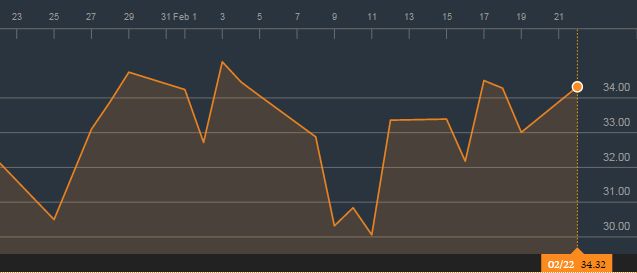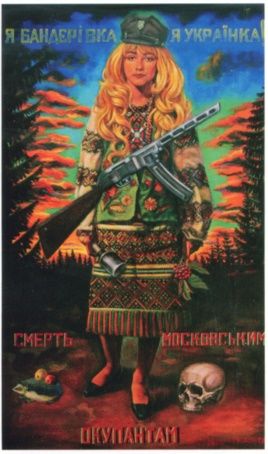LIVE UPDATES: An opposition report based on both open sources and the testimony of sources who fear revealing their names details the alarming growth of Chechen leader Ramzan Kadyrov’s “personal army” to 30,000 men and the atmosphere of intimidation that reigns in the republic.
Welcome to our column, Russia Update, where we will be closely following day-to-day developments in Russia, including the Russian government’s foreign and domestic policies.
The previous issue is here.
Recent Translations:
–The Non-Hybrid War
–Kashin Explains His ‘Letter to Leaders’ on ‘Fontanka Office’
–TV Rain Interviews Volunteer Fighter Back from Donbass
–‘I Was on Active Duty’: Interview with Captured GRU Officer Aleksandrov
UPDATES BELOW
One reason for oil’s rise — the idling of US oil rigs. Business Today reports:
A falling rig count in the United States which is expected to lead to a decline in 2016 production helped support prices, analysts said.
“The US oil rig count continued to decline…, with a total of 26 rigs idled,” Goldman Sachs said. “The current rig count implies… annual average US production would decrease by 445,000 barrels per day yoy (year-on-year) on average in 2016,” it added.
“We expect drops in US production to be the source of bullishness,” Singapore-based brokerage Phillip Futures said.
There are also reports that major oil suppliers have agreed to some sort of a production freeze. Reuters points out that investors increasingly think that oil will not go much lower than it currently is.
Prices got a further boost after the International Energy Agency, the world’s oil consumer body, said U.S. shale oil production could fall by 600,000 barrels per day (bpd) this year and another 200,000 bpd in 2017.
Higher equity prices on Wall Street also supported oil, as shares of oil companies such as Chevron (CVX.N) rose. [.N]
“For various reasons, traders are growing convinced that the market won’t go much lower,” said Pete Donovan, crude broker at Liquidity Energy in New York.
“This includes the falling U.S. rig count, the output freeze OPEC is trying to achieve with non-OPEC members, the apparent lack of Iranian barrels flooding the market after the sanction lifted against them and the potential for geopolitical stress,” he added, referring to a proposed freeze at January levels by Russia and the Organization of the Petroleum Exporting Countries.
But as Bloomberg argues, “what we’re seeing is a production freeze without a decrease in production.” With the amount of extra oil coming out of OPEC, and the huge amount of stored supply, many experts believe that prices may stabilize but may not really rally until sometime next year:
“The market is going toward stabilization,” Chakib Khelil, former Algerian minister of energy, said in an interview with Bloomberg Television. “Saudi Arabia has achieved its objective to cut non-OPEC production” and the output freeze is “a good start that we can build on” to rebalance the market, he said.
The agreement to freeze output includes Qatar and Venezuela and is the “beginning of a process” that could require “other steps to stabilize and improve the market,” Saudi Oil Minister Ali al-Naimi said after the talks last week. The kingdom pumped 10.2 million barrels a day last month, according to data compiled by Bloomberg. Russia produced 10.9 million, a post-Soviet record.
While Nigeria, a fellow a member of the Organization of Petroleum Exporting Countries, backs the freeze, Iran and Iraq should be allowed to recover lost market share, Minister of State for Petroleum Resources Emmanuel Kachikwu said Sunday.
The ruble is also rallying. As of writing it is trading at 75.05 to a US dollar — perhaps headed toward its best close in more than a month — and 82.67 rubles to a euro. According to Bloomberg, developing-nation stocks hit a six-month high and the ruble outperformed all other developing currencies.
The American stock markets are all about about 1.5%, European markets are doing even better, and both the Nikkei and Hang Sang indexes are up nearly 1% as of writing, according to Market Watch.
Despite the rally in the ruble and the price of oil, it should be remembered that the Russian government projected their 2016 budget with the expectation that Brent would be trading at about $50 a barrel. Every day below that is costing the Russian government a lot of money, and we’ve yet to see any evidence that Russian exports are rallying.
— James Miller
Vologzheninova, a single mother who lives in Yekaterinburg, was sentenced to 320 hours of community service by the Yekaterinburg District Court for her posts, including a social media meme that shows a Ukrainian woman in national dress with a machine gun and the slogans, “I am a Banderaite, I’m a Ukrainian!” and “Death to Moscow Occupiers!”. Banderaites are admirers of Stepan Bandera, a controversial 20th century Ukrainian war commander.
Asked by a reporter if she would now be more careful about what she wrote, Vologzheninova said “Perhaps, but my convictions have not been changed at all by this sentence.” Asked if she worried about getting arrested again, she responded with the old Russian proverb, “You cannot forswear the beggar’s pouch or prison,” i.e. you cannot escape such a fate in Russia.
Diplomats from the UK, Germany, France, Czech Republic and Sweden attended a hearing in Vologzheninova’s trial in January, and Amnesty International took up her case as a prisoner of conscience, Grani.ru reported, citing the Urals news service Ura.ru
— Catherine A. Fitzpatrick
Yashin said that he sees the Russian opposition as defending the interests of the Chechen people who have been subjected to confiscatory policies and persecution by Kadyrov.
— Catherine A. Fitzpatrick
An opposition report based on both open sources and the testimony of sources who fear revealing their names details the alarming growth of Chechen leader Ramzan Kadyrov’s “personal army” to 30,000 men and the atmosphere of intimidation that reigns in the republic.
Opposition activist Ilya Yashin, a close colleague of slain opposition leader Boris Nemtsov, deputy chair of the Parnas party and founder of the Solidarity movement is author of the report, titled A Threat to National Security. To provide documentation for the report, he traveled to Grozny in secret after being turned down for a formal meeting by Kadyrov.
The report will be available February 23 at putin-itogi.ru; it is the 72nd anniversary of Stalin’s mass deportation of the Chechen people and also Fatherland Defense Day (formerly Soviet Army Day).
In an interview with Free-News Volga last week, Yashin recounted that Chechen business people told him they were giving their profits to the Kadyrov Fund, an opaque entity ostensibly involved in charitable work but which locals believe enables Kadyrov, his family and his close associates to live in luxury. Chechnya receives a subsidy of $1 billion a year from Moscow, but people live in poverty.
Back in December 2014, two months before his death, when Nemtsov called attention to Kadyrov’s army, made up of Interior Ministry police and troops, the figure given by Russian media was 20,000 men; today it has grown to 30,000, says Yashin.
In another interview, with rus2web.ru, Yashin said that he used many open sources to compile material about Kadyrov, but also found journalists who had compiled files over the years on Chechnya’s strongman but were unable to publish it due to the self-censorship of their editors. They were happy to turn such items over to Yashin to site.
Yashin plans to release the report in Moscow, St. Petersburg in other cities at opposition kiosks and then distribute it “underground” in Chechnya like Soviet-era publications known as samizdat, as it would not be authorized for publication.
Given the repeated verbal threats made against Russian opposition figures in recent weeks, and attacks made in person, Yashin asked for police protection for tomorrow’s press conference but was refused, Ekho Moskvy reported.
New Times has published a chapter of the report today; an excerpt is viewable but the rest is behind a paywall.
New Times noted that after Yashin asked for a meeting with Kadyrov, instead he was targeted by Kadyrov among the opposition figures featured on hate posters at the “million Muslim march” in Grozny on January 22.
The following is an excerpt of the report carried in New Times, translated by The Interpreter:
In late December 2014, Ramzan Kadyrov conducted in Grozny a large-scale review of the armed units under his control. At the city stadium, he lined up about 20,000 completely equipped and armed fighters. After making a kind of honor round before his soldiers, Kadyrov gave a speech in which he called himself and those gathered “Putin’s infantry.”
There was a certain deception in the Chechen leader’s words. The thousands of armed warriors gathered at the stadium are the combat infantry of Kadyrov himself, subordinate above all to him personally and not the federal authorities. Only in Chechnya does the Kremlin allow the creation of local divisions controlled de-factor only by the head of the republic. Kadyrov’s battalions remain the only armed formations in Russia made up according to ethnic affiliation, although this is not provided by law.
The personal loyalty of Kadyrov’s fighters is conditioned above all by the biographies of many of them. The core of the power structures in Chechnya is made up of former separatists who were amnestied by decision of the head of the republic. Kadyrov provided them the opportunity to once again take up arms, but already under his control. Thus, fighters who battled the Russian army are obliged to Kadyrov not only for their jobs and salaries, but all their freedom and their lives.
The total number of armed Kadyrovites, according to the estimates of experts is approximately 30,000 men. A significant number of them are formally officers of the Russian Interior Ministry or servicemen in the Interior Troops of Russia. Essentially these armed formation soperating on Chechen territory do not dependent on the federal agencie of the government and are loyal only to the president of Chechnya.
The troops show their loyalty to the head of the republic often by demonstrating specific details of their uniform: for example, their caps and shoulder patches have the initials “KRA” which stands for Kadyrov Ramzan Akhmatovich. Car license plates with the letters “KRA” in Chechnya almost always indicated the affiliation of the owner of the car to the poewr ministries or administrative agencies of the republic.
“Can you imagine a policeman in Moscow with a cap vearing the initials of Sobyanin? Or in Nizhny Novgorod with the initials of Shantsev?” Dmitry Gudkov, a deputy of the State Duma asked. “in all Russian regions, Interior Ministry officers and service personnal take an oath, but in Chechnya, they in fact swear allegiance personally to Kadyrov.”
Yashin writes that children as young as 12 are trained to become fighters in a Chechen state-sponsored organization called “Young Fortress.” Kadyrov’s spetsnaz is headed by a Russian, Daniil Martyonv, who left the elite Alfa spetsnaz group in Moscow to come and train Kadyrov’s warriors. Martynov’s former colleagues consider his actions to be a betrayal, as they fear that armed Chechens will once again turn their weapons on Russian soldiers.
— Catherine A. Fitzpatrick

